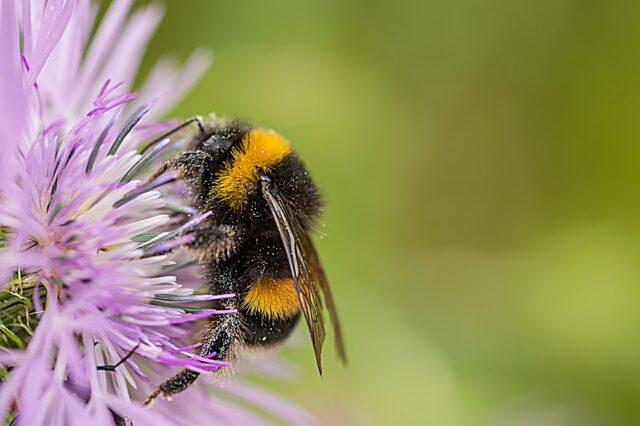This site may earn affiliate commissions from the links on this page. Terms of use.
(Photo: Eduardo Goody/Unsplash)Dogs, cats, primates, and even some birds are known to play for enjoyment’s sake—but what about bumble bees? A new study has revealed that these adorably fuzzy bees seek out fun by playing with toys, even without any survival incentive to do so.
Researchers from the United Kingdom’s Queen Mary University and the University of Sheffield recently sought to uncover whether insects engage in play. A study from 2017 found that bumble bees could be trained to roll balls for a reward; taken a step further, the same concept could be applied to research on bees’ “recreational” behaviors. The researchers obtained multiple commercial bumble bee colonies housed in a container that mimicked their natural nesting environment. To avoid distressing the bees, the researchers handled the insects as little as possible and gave them as much pollen and sugar water as they wanted. They also adjusted the lab’s lighting to simulate night and day.
Attached to the bees’ nest was a tunnel leading to the experimental arena, which contained small wooden balls in one area and food in another. The path past the balls and to the food was left unobstructed. A total of 45 bumble bees were allowed through the tunnel and into the arena; from here, they had the freedom to interact with the balls, feed, or leave at any time. On the first day of the experiment, all 45 bees completed “intentional” (0.4 seconds or longer) ball rolls at least once, with some rolling the balls up to 44 times. The next day, 37 bees returned to interact with the wooden balls, even after they’d finished feeding on pollen and sugar water.

(Image: Dona et al, Animal Behaviour)
At no point were any of the bees incentivized (i.e. rewarded with food or rest) for rolling the balls. The researchers also eliminated the possibility that the bees were attempting to mate or clear debris. As a result, the researchers believe they were engaging in play, or recreational behavior lacking immediate survival benefits.
As with other creatures, it appears bumble bees’ interest in play is influenced by their age. A second version of the researchers’ experiment monitored two distinct groups: bees under and over 10 days of age. Younger bees interacted with the wooden balls more, particularly between the ages of three and seven days. Males also interacted with the balls longer than their female counterparts.
Though play is typically enjoyed in the moment thanks to its associations with relaxation and delight, scientists believe it might serve a larger function. Humans and other animals are encouraged to play in their youth to promote the healthy development of certain cognitive and motor abilities. Still, the researchers in the UK think there’s a chance bees play in an effort to achieve a “positive emotional state,” however rudimentary that might be.
Now Read:
Source by www.extremetech.com





























